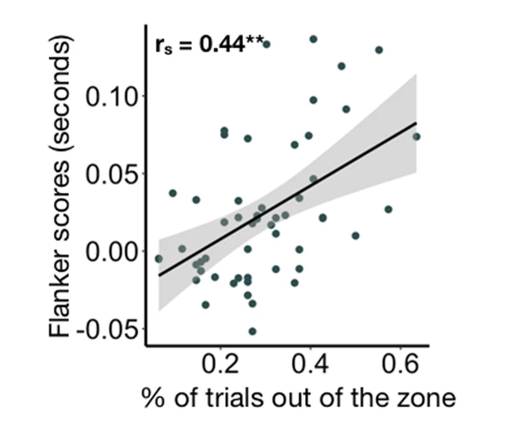Here’s a challenge. While you read this post, I want you to stay completely focused. Don’t let your attention drift – no checking emails, thinking about your lunch plans, or petting your dog. Sounds easy enough, right?
Sometimes, it’s hard to pay attention. Sometimes the task is too difficult, sometimes other things distract you, or sometimes the thing requiring your attention is just really boring. Research has found that fluctuations in maintaining focused attention are normal, though they do come with a cost.
In a recent article published in the Psychonomic Society’s journal Psychonomic Bulletin & Review, the authors questioned the commonly held belief that attentional lapses are always bad. Researchers Alexandra Decker, Michael Dubois, Katherine Duncan, and Amy Finn (pictured below) asked a specific question: how do changes in sustained attention influence learning of seemingly irrelevant peripheral information?
Based on the high prevalence of losing attention, the authors pondered the reason for it,
“Lapses in attention are extremely common—we experience them every day, and may even spend up to 50% of the day thinking about things that are not directly relevant to whatever we are doing. Why does losing focus occur—does it serve any useful purpose?”

Previous research has explained attentional lapses with two opposing theories, overload and underload. According to overload theories, the limited cognitive resources that most functions share is depleted over time or with more demand. Attentional lapses result from a complete depletion of these resources and lead to impairments overall.
In contrast, underload theories suggest that when a task becomes too boring, we divert our cognitive resources to something else. These attentional lapses might lead our mind to an internal (e.g., thinking about what you have to do later that day) or external (e.g., thinking about the sound you just heard) destination, or nowhere at all (e.g., a blank mind).
The researchers were particularly interested in how attentional lapses may lead to redirecting the focus of attention away from the main task goal and to the other things on the screen, and how that redirection might lead to learning.
To test this, participants completed a correlated flanker task. As shown in the image below, this task involved participants identifying if the item in the center of the screen was a letter or a number. On both sides of the central item, or target, was a pair of identical symbols, flanking the item. While participants were told to ignore these distractor symbols, they were important to the research question. One type of flanker symbol usually appeared with letter targets, and another usually appeared with number targets, though the participants weren’t told about this beforehand. Another flanker symbol was equally likely to be seen with letters or numbers, considered neutral. How often the target-distractor pairs occurred varied, with some frequently occurring (in 66% of trials) and some rarely occurring (in 8% of trials). The neutral trials filled in the remaining trials. Participants completed over 350 trials of this long, dare I say, monotonous experiment.

Overall, participants learned the relationships. When the more common target-flanker groups appeared, participant responses were faster and more accurate compared to the less common or neutral groups. They also showed learning gradually as the task progressed. At the beginning of the experiment, performance was similar for all target-flanker groups, with differences emerging in the middle and end of the experiment.
The researchers then determined how “out of the zone” or “in the zone” each participant was during the whole experiment, based on their reaction times. They found that participants who experienced more attentional lapses showed more learning of the relationships between the target and flanker items, as seen in the figure below. Further, participants who spent more time “out of the zone” early in the task showed the most learning overall. These findings provide support for the underload theories.

But did people know they were learning? At the end of the experiment, participants were asked if they noticed any patterns in the stimuli. If they said yes, they were asked to describe the pattern. Only 26% of participants reported noticing a pattern – but just five correctly identified that it was about the targets and the flankers.

The authors’ interpretation of the meaning of their findings are
“Like the zoom lens on a camera, if we focus too narrowly on our goals and tasks all the time, we might miss the richness and complexity of the world around us, and fail to learn about information that can later prove useful when our goals change. So perhaps we should give ourselves a break by worrying less when our minds take a break.”
So, these results mean great news. If you failed my challenge and experienced some attentional lapses while reading this post – don’t worry! You probably still learned something (even if you don’t realize it).
Featured Psychonomic Society article:
Decker, A., Dubois, M., Duncan, K., & Finn, A. S. (2022). Pay attention and you might miss it: Greater learning during attentional lapses. Psychonomic Bulletin & Review, 1-12. https://doi.org/10.3758/s13423-022-02226-6
